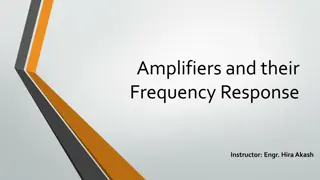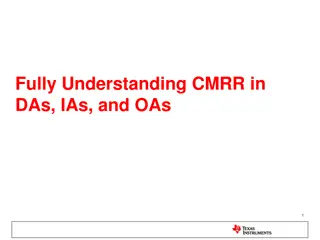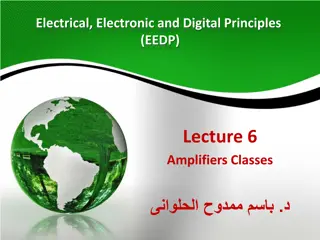Transimpedance Amplifiers in CMOS Technology for Optical Communications at 40 Gb/s
This research by Joseph Chong at Virginia Tech delves into the use of transimpedance amplifiers (TIAs) in CMOS technology for optical communications operating at a data rate of 40 Gb/s. The study outlines the motivation behind the project, the role of TIAs in optical receivers, TIA circuit topologies, recent literature, proposed designs, and conclusions drawn. It explores the performance metrics of TIAs, such as gain, group delay variation, bandwidth, and noise. The aim is to enhance the efficiency and integration capabilities of optical communication systems, with a particular focus on achieving high data rates using CMOS technology.
Download Presentation

Please find below an Image/Link to download the presentation.
The content on the website is provided AS IS for your information and personal use only. It may not be sold, licensed, or shared on other websites without obtaining consent from the author.If you encounter any issues during the download, it is possible that the publisher has removed the file from their server.
You are allowed to download the files provided on this website for personal or commercial use, subject to the condition that they are used lawfully. All files are the property of their respective owners.
The content on the website is provided AS IS for your information and personal use only. It may not be sold, licensed, or shared on other websites without obtaining consent from the author.
E N D
Presentation Transcript
Transimpedance Amplifiers in CMOS Technology for Optical Communications over the Data Rate of 40 Gb/s Joseph Chong Dept. of Electrical and Computer Eng. Virginia Tech April 18, 2014 1
Outline Outline Motivation Role of Transimpedance Amplifier (TIA) TIA Circuit Topologies Recent Literature Proposed Design Conclusion 2
Motivation Motivation IEEE 802.3 supports 40 Gb/s and 100 Gb/s. Achieved with multiple channels such as 4 x 10 Gb/s. Multiple channels pose drawbacks including: Inter-channel crosstalk. Large size. Possible of larger power consumption Mitigate drawbacks by reducing the number of channels. Much more with CMOS technology: lower power comparing to other techs, and enables integration. Toward future standard of 400 Gb/s, is it possible to get 1 x 100 Gb/s in CMOS? 3
TIA in Optical Receiver TIA in Optical Receiver On-off keying modulated input. Optical electrical by photodiode. Iin Vout with TIA. Restores clock & process data. 5
Photodiode Photodiode A P-I-N diode has a wider depletion region. Reversed biased and equivalent to a capacitor. Optical power input controls an AC current source. 6
TIA Performance TIA Performance TIA dominates performance of receiver. Performance metrics: Gain Group delay variation Bandwidth Noise Will be discussed in next section. 7
Transimpedance Gain Transimpedance Gain Transfer function: Transimpedance gain In decibel (dB) scale: 8
Group Delay Group Delay Transfer function Obtain group delay (GD) from phase. Group delay variation (GDV) is max min within bandwidth. 9
Bandwidth Bandwidth A digital signal has wide range of frequency components. Bandwidth (BW) of TIA requires a pass band from near DC to near f0. 3-dB frequency is where ZT is 1/2 of low frequency gain. A rule of thumb relates 3-dB freq. to data rate. f0 f3dB Image courtesy of http://edn.com/design/test-and-measurement/4422710/The- basics-of-digital-signal-spectra 10
Bandwidth Bandwidth 40 Gb/s 100 Gb/s f3dB f0 f0 = 40 GHz f0 = 100 GHz f3dB = 28 GHz f3dB = 70 GHz Image courtesy of http://edn.com/design/test-and-measurement/4422710/The-basics-of- digital-signal-spectra 11
Representative TIA Representative TIA Two commonly used circuit topologies: Common gate (CG) amplifier Shunt-feedback (S-FB) amplifier 13
CG: Gain and Bandwidth CG: Gain and Bandwidth Transfer function: Low freq gain = RD 0 0 Pole frequency associated with CPD: Increase gm1 for larger bandwidth. Increase width of M1 Increase bias current larger Cgs RD voltage drop 14
CG: Noise at Vout CG: Noise at Vout Noise from RD: Noise from M1 and M2 : Vout due to superposition of current sources : How to compare noise with other TIA? Larger gain larger output noise, but not worse signal-to-noise ratio. 15
Input Referred Noise Input Referred Noise Compare by the equivalent input noise current (input referred noise). Calculation procedure: Output noise due to resistor RD Transfer function Input referred noise Enables fair comparisons between designs. 16
CG: Input Referred Noise CG: Input Referred Noise Express noise in current density: mean square current per hertz. Observe from equation above, noise of RD and M2 is directly referred to the input. 17
S S- -FB: Gain and Bandwidth FB: Gain and Bandwidth A Shunt feedback (S-FB) amplifier is composed of a voltage amplifier with gain A and RF as feedback. Transimpedance gain At A>>1, Low freq gain = RF 1 0 Pole frequency 18
S S- -FB: Input Referred Noise FB: Input Referred Noise Noise of amplifier A is modeled as voltage Input referred noise: 19
Comparison: Noise Comparison: Noise Comparing low frequency noise The noises from RD and RF are identical. The noise from Vn,A can be smaller than the noise from M2. 20
Comparison: Bandwidth Comparison: Bandwidth CG s dominant pole is associated with 1/gm. S-FB s pole is associated with RF/A, which can be larger than 1/gm. 21
Possibility for 40 Gb/s? Possibility for 40 Gb/s? Some numerical examples for the two topologies. ZT = RD = RF = 200 = 46dB Input pole frequency = 15.9GHz. How to achieve 40Gb/s? 22
Filling the Gap Filling the Gap 23
Part 3: Recent Literature (Bandwidth Enhancement Techniques) 24
Methods of Bandwidth Methods of Bandwidth Enhancement Enhancement Series interstage inductor -type inductor network Triple resonance network gm-boosting topology Inductors Circuit Topology 25
Series Inductor (1) Series Inductor (1) Transfer function: Parameters: J. Kim and J. F. Buckwalter, Bandwidth Enhancement With Low Group-Delay Variation for a 40-Gb/s Transimpedance Amplifier, IEEE Trans. Circuits Syst. I Regul. Pap., vol. 57, no. 8, pp. 1964 1972, 2010. 26
Series Inductor (2) Series Inductor (2) Optimal m value, which translates to L value, provides adequate BW enhancement and minimal GDV. Gain Group Delay GDV BW J. Kim and J. F. Buckwalter, Bandwidth Enhancement With Low Group-Delay Variation for a 40-Gb/s Transimpedance Amplifier, IEEE Trans. Circuits Syst. I Regul. Pap., vol. 57, no. 8, pp. 1964 1972, 2010. 27
Series Inductor (3) Series Inductor (3) The first work (2010) is a S-FB amplifier followed by 2 stages of post-amplifiers in 0.13 m CMOS. Bandwidth is extended from 5GHz to 30GHz. GDV is kept within 12ps. J. Kim and J. F. Buckwalter, Bandwidth Enhancement With Low Group-Delay Variation for a 40-Gb/s Transimpedance Amplifier, IEEE Trans. Circuits Syst. I Regul. Pap., vol. 57, no. 8, pp. 1964 1972, 2010. 28
Series Inductor (4) Series Inductor (4) The second work (2012) is a push-pull S-FB amplifier followed by one stage of post-amplifier fabricated in 45 nm SOI CMOS. Bandwidth is extended from 25 GHz to 33 GHz. GDV is kept within 6ps. J. Kim and J. F. Buckwalter, A 40-Gb/s Optical Transceiver Front-End in 45 nm SOI CMOS, IEEE J. Solid State Circuits, vol. 47, no. 3, pp. 615 626, 2012. 29
- -type Inductor Peaking (1) type Inductor Peaking (1) A -type inductor peaking utilizes three interstage inductors for bandwidth enhancement purposes. The small signal equivalent circuit shows that: Cd is the drain capacitance of 1st stage. Cg is the gate capacitance (of next stage). J.-D. Jin and S. S. H. Hsu, A 40-Gb/s Transimpedance Amplifier in 0.18-um CMOS Technology, IEEE J. Solid State Circuits, vol. 43, no. 6, pp. 1449 1457, 2008. 30
- -type Inductor Peaking (2) type Inductor Peaking (2) Gain enhancement of more than 3 times is achieved. J.-D. Jin and S. S. H. Hsu, A 40-Gb/s Transimpedance Amplifier in 0.18-um CMOS Technology, IEEE J. Solid State Circuits, vol. 43, no. 6, pp. 1449 1457, 2008. 31
- -type Inductor Peaking (3) type Inductor Peaking (3) Jin and Hsu proposed a four-stage common source amplifier with -type inductor peaking in 0.18 m CMOS. 3-dB bandwidth is extended from 5GHz to 30GHz. J.-D. Jin and S. S. H. Hsu, A 40-Gb/s Transimpedance Amplifier in 0.18-um CMOS Technology, IEEE J. Solid State Circuits, vol. 43, no. 6, pp. 1449 1457, 2008. 32
TRN (1) TRN (1) A triple resonance network (TRN) is composed of one series inductor and one shunt inductor. Reverse TRN has R1 and L1 connected to C2. Entire network can be simplified as a circuit of C parallel with RL. C.-F. Liao and S.-I. Liu, 40 Gb/s Transimpedance-AGC Amplifier and CDR Circuit for Broadband Data Receivers in 90 nm CMOS, IEEE J. Solid-State Circuits, vol. 43, no. 3, pp. 642 655, 2008. 33
TRN (2) TRN (2) Drain impedance: Three resonance frequencies: 1: ( Req and Leq branch is inf.) 2: ( Ceq branch is inf.) 3: Ztot is pure resistive C.-F. Liao and S.-I. Liu, 40 Gb/s Transimpedance-AGC Amplifier and CDR Circuit for Broadband Data Receivers in 90 nm CMOS, IEEE J. Solid-State Circuits, vol. 43, no. 3, pp. 642 655, 2008. 34
TRN (3) TRN (3) A S-FB CG in 90 nm CMOS by Liao and Liu (2008). Bandwidth enhancement from 5GHz to 40GHz. C.-F. Liao and S.-I. Liu, 40 Gb/s Transimpedance-AGC Amplifier and CDR Circuit for Broadband Data Receivers in 90 nm CMOS, IEEE J. Solid-State Circuits, vol. 43, no. 3, pp. 642 655, 2008. 35
Inductor Peaking Inductor Peaking Downsides Downsides Three types of inductor peaking presented shows attractive results However, there are some downsides. Inductors occupies large chip area. Large inductors have low self resonance freq. On chip inductors have low Q value. Series inductors extend bandwidth while increasing frequency dependent delay. 36
Implementation of On Chip Implementation of On Chip Inductors Inductors On chip inductors are implemented as spiral metal. Commonly used model shows capacitance coupling, parasitic loss and substrate loss. 37
Inductor Parameters Inductor Parameters Convert the inductor model to a parallel RLC circuit. Definition of self resonance frequency (SRF): Definition of Q value: 38
Self Resonance Frequency Self Resonance Frequency After the inductor s self resonance frequency, capacitance becomes dominant in the structure. inductor imag(Z)/ capacitor freq (GHz) 39
Effect of Q value Effect of Q value Lower Q value causes deterioration of bandwidth enhancement effect. Normalized Vout (dB) No Inductor Q=10 Q=25 freq (GHz) 40
g gm m- -boosting (1) boosting (1) Based on CG amplifier M1 and R1. Common source M2 and R2 feeds to gate of M1. Input resistance: Transfer function: Pole associated with CPD: 41
g gm m- -boosting (2) boosting (2) Bashiri and Plett (2010) proposed gm-boosting with inductor peaking design in 65nm CMOS. Achieves 2 times bandwidth enhancement. S. Bashiri and C. Plett, A 40 Gb/s transimpedance amplifier in 65 nm CMOS, in IEEE International Symposium on Circuits and Systems (ISCAS), 2010, pp. 757 760. 42
Summary of Techniques Summary of Techniques CMOS Process ZT (dB ) Enhanced BW Bandwidth Enhancement Techniques Ref. Jin & Hsu 2008 0.18 m 51 30.5 -type inductor peaking Liao & Liu 2008 90 nm 60 40 Reverse triple resonance Kim & Buckwalter 2010 Kim & Buckwalter 2012 Bashiri & Plett 2010 0.13 m 50 29 Series interstage inductor 45 nm SOI 55 41 Series interstage inductor 65 nm 46.7 38 gm-boosting with inductors >28GHz, Works at 40 Gb/s! 43
Part 4 Proposed Design for 100 Gb/s 44
Overall Circuit Overall Circuit gm-boosting transimpedance stage Capacitive degeneration stage Inductive peaking Differential signaling 45
gm gm- -boosting Stage boosting Stage Transfer function: L1 and L3 introduce peaking in transfer function. 46
Capacitive Degeneration Capacitive Degeneration Voltage gain function: Zero can be used to compensate a pole. 47
TIA Bandwidth and Gain TIA Bandwidth and Gain Bandwidth: 75 GHz >70GHz, Works at 100 Gb/s! Gain: 40 dB -3dB 75 48
Comparison Comparison Figure of merit BW(GHz) x ZT,mag / Power (mW) . BW (GHz) ZT (dB ) GDV (ps) Noise (pA/ Hz) Power (mW) Ref. Process FOM Proposed Design Jin & Hsu 2008 Liao & Liu 2008 Kim & Buckwalter 2010 Kim & Buckwalter 2012 Bashiri & Plett 2010 65 nm 75 40 8.7 31 24 312.5 0.18 m 30.5 51 150 55.7 60.1 180.1 90 nm 22 60 n/a 22 75 293.3 0.13 m 29 50 12 51.8 45.7 200.7 45 nm SOI 30 55 7.8 20.5 9 1874.5 65 nm 19 46.7 13 30 39.9 103.0 49
Conclusion Conclusion IEEE standard has motivated several 40 Gb/s TIA in CMOS, which target low power and high integration application. Most TIA designs are based on CG or S-FB circuit. Bandwidth enhancement techniques are necessary for 40 Gb/s and beyond. Inductor peaking is the most widely used technique. A TIA designed in 65nm CMOS achieves 75 GHz bandwidth, shows promising results to work at a 100 Gb/s data rate. 50























